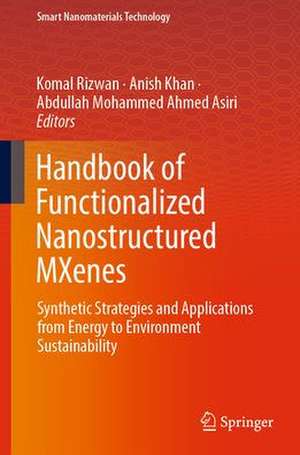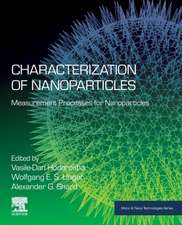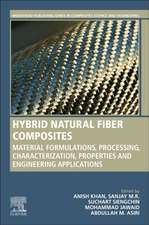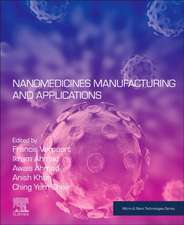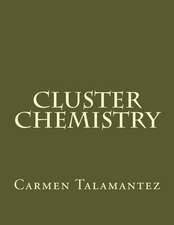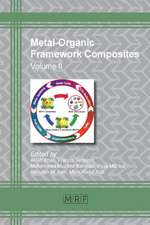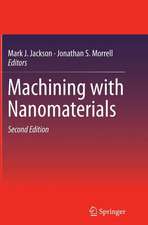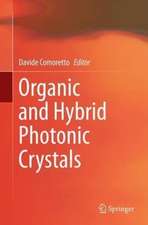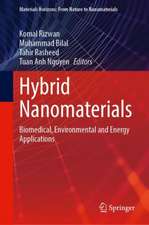Handbook of Functionalized Nanostructured MXenes: Synthetic Strategies and Applications from Energy to Environment Sustainability: Smart Nanomaterials Technology
Editat de Komal Rizwan, Anish Khan, Abdullah Mohammed Ahmed Asirien Limba Engleză Hardback – 2 iul 2023
Din seria Smart Nanomaterials Technology
- 24%
 Preț: 942.83 lei
Preț: 942.83 lei - 18%
 Preț: 1015.23 lei
Preț: 1015.23 lei - 18%
 Preț: 1118.62 lei
Preț: 1118.62 lei - 18%
 Preț: 1016.01 lei
Preț: 1016.01 lei - 18%
 Preț: 1117.50 lei
Preț: 1117.50 lei - 18%
 Preț: 1222.80 lei
Preț: 1222.80 lei - 18%
 Preț: 1112.60 lei
Preț: 1112.60 lei - 18%
 Preț: 1004.67 lei
Preț: 1004.67 lei - 18%
 Preț: 1114.34 lei
Preț: 1114.34 lei - 18%
 Preț: 1114.83 lei
Preț: 1114.83 lei - 18%
 Preț: 1003.70 lei
Preț: 1003.70 lei - 18%
 Preț: 953.82 lei
Preț: 953.82 lei - 18%
 Preț: 1118.75 lei
Preț: 1118.75 lei - 24%
 Preț: 904.97 lei
Preț: 904.97 lei - 18%
 Preț: 1116.26 lei
Preț: 1116.26 lei
Preț: 2099.29 lei
Preț vechi: 2560.10 lei
-18% Nou
Puncte Express: 3149
Preț estimativ în valută:
401.74€ • 436.24$ • 337.47£
401.74€ • 436.24$ • 337.47£
Carte tipărită la comandă
Livrare economică 22 aprilie-06 mai
Preluare comenzi: 021 569.72.76
Specificații
ISBN-13: 9789819920372
ISBN-10: 981992037X
Ilustrații: XIV, 387 p. 37 illus., 36 illus. in color.
Dimensiuni: 155 x 235 mm
Greutate: 0.74 kg
Ediția:2023
Editura: Springer Nature Singapore
Colecția Springer
Seria Smart Nanomaterials Technology
Locul publicării:Singapore, Singapore
ISBN-10: 981992037X
Ilustrații: XIV, 387 p. 37 illus., 36 illus. in color.
Dimensiuni: 155 x 235 mm
Greutate: 0.74 kg
Ediția:2023
Editura: Springer Nature Singapore
Colecția Springer
Seria Smart Nanomaterials Technology
Locul publicării:Singapore, Singapore
Cuprins
Introduction to MXenes.- Structural design, properties and synthesis of original MXenes.- Structural design and synthesis of elemental doped MXenes and MXenes based Composites.- Functionalized MXene based polymer composites.- Fabrication and structural design of MXene based hydrogels.- Emerging trends for supercapacitors.- Recent advancement in Lithium ion batteries.- MXene based Sodium ion batteries.- Design and applications of MXene based Li-S ion batteries.- Functionalized MXene films for energy storage applications.- Developments in MXene composites for thermal energy storage.- Nanostructured MXenes for hydrogen storage for energy applications.- Generation and conversion of Energy through MXene based electrodes.- Diverse applications of MXene composites for electrochemical energy storage.- Potential of Nanoengineered MXenes in photocatalysis.- Insight into promising role of MXene composites in electrocatalysis.- Promising applications of MXenes in optoelectronic device.- Efficacy of MXene based materials in Removal of gases.- Environmental remediation of heavy metals through MXene composites.- Advanced approach of MXene based materials in Removal of radionuclides.- Potential role of MXene based materials in mitigation of organic contaminants.- Functionalized MXene conjugates in removal of Pharmaceutical based pollutants.- Potential mitigation of dyes through MXene composites.- Applications of MXene based materials in gas sensing.- Recent advances in MXene based electrochemical sensors pollutants.- Biosensing applications of MXene composites.- Diverse applications of MXene composites in optical sensing.- Miscellaneous Applications of other MXene based sensors.- Toxicology, stability, and environmental impacts of MXenes.- Challenges and future prospective of MXenes.
Notă biografică
Dr. Komal Rizwan is Assistant Professor in Chemistry Department—Faculty of Science University of Sahiwal, Pakistan. She earned Ph.D. in chemistry from Government college University Faisalabad, Pakistan in 2016 and also carried out PhD research work at University of Pennsylvania, Philadelphia, United States. Currently, She is working as postdoctoral fellow at Department of Biochemistry and Biophysics, Perelman School of Medicine, University of Pennsylvania, Philadelphia, USA. Dr. Komal Rizwan is author of more than 100 research publications printed in world's leading scientific societies and she is also serving as corresponding editor of many books of springer and Elsevier. Her research group is interested to synthesize molecules that possess interesting functions including biological activity (natural products, drugs, drug-like compounds, etc.) or materials with useful properties, where she develop tools to perform efficient synthetic transformations in the creation of novel moleculararchitectures of medicinal or industrial relevance. In a nutshell, her interests are broadly in the area of synthetic organic chemistry, with a particular focus in the synthesis of bioactive natural products and novel molecular architectures (nanomaterials). Dr. Rizwan's research group is also focusing on synthesis of nonlinear optical compounds, and computational part of her laboratory contributes to a fundamental understanding of the electronic structure and properties of nonlinear optical materials that are being considered in the design of electro-optics.
Dr. Anish Khan is currently working as Assistant Professor, Chemistry Department, Centre of Excellence for Advanced Materials Research (CEAMR), Faculty of Science, King Abdulaziz University, Jeddah, Saudi Arabia, and has Ph.D. from Aligarh Muslim University, India, from 2010. He has a research experience of working in the field of synthetic polymers and organic–inorganic electrically conducting nano-composites. Hecompleted Postdoctoral from School of Chemical Sciences, University Sains Malaysia (USM), in electroanalytical chemistry in 2010–2011. He has research and teaching experience of more than 250 research articles published in refereed international journal, more than 20 international conferences/ workshop and 40 books published and 20 in progress and 70 chapters. He has around 20 research projects completed. He is Managerial Editor of Chemical and Environmental Research (CER) Journal and Member of American Nano Society. His field of specialization is polymer nanocomposite/cation-exchanger/chemical sensor/microbiosensor/ nanotechnology, application of nanomaterials in electroanalytical chemistry, material chemistry, ion-exchange chromatography, and electroanalytical chemistry, dealing with the synthesis, characterization (using different analytical techniques), and derivatization of inorganic ion-exchanger by the incorporation of electrically conducting polymers, preparation and characterization of hybrid nanocomposite materials and their applications, polymeric inorganic cation-exchange materials, electrically conducting polymeric, materials, composite material use as sensors, green chemistry by remediation of pollution, heavy metal ion selective membrane electrode, and biosensor on neurotransmitter.
Prof. Abdullah Mohammed Ahmed Asiri is Professor in Chemistry Department—Faculty of Science—King Abdulaziz University. He has Ph.D. (1995) from University of Wales, College of Cardiff, UK, on tribochromic compounds and their applications. He is Chairman of the Chemistry Department, King Abdulaziz University, currently and also Director of the Center of Excellence for advanced Materials Research. He is Director of Education Affair Unit–Deanship of Community services and Member of Advisory Committee for advancing materials (National Technology Plan, King Abdul Aziz City of Science and Technology, Riyadh, Saudi Arabia). His area of interestincludes color chemistry, synthesis of novel photochromic and thermochromic systems, synthesis of novel colorants and coloration of textiles and plastics, molecular modeling, applications of organic materials into optics such as OEDS, high performance organic dyes and pigments, new applications of organic photochromic compounds in new novelty, organic synthesis of heterocyclic compounds as precursor for dyes, synthesis of polymers functionalized with organic dyes, preparation of some coating formulations for different applications, and photodynamic thereby using organic dyes and Pigments Virtual Labs and Experimental Simulations. He is Member of Editorial Board of Journal of Saudi Chemical Society, Journal of King Abdul Aziz University, Pigment and Resin Technology Journal, Organic Chemistry Insights, Libertas Academica, Recent Patents on Materials Science, and Bentham Science Publishers Ltd. Besides that he has professional membership of International and National Society and Professional bodies.
Dr. Anish Khan is currently working as Assistant Professor, Chemistry Department, Centre of Excellence for Advanced Materials Research (CEAMR), Faculty of Science, King Abdulaziz University, Jeddah, Saudi Arabia, and has Ph.D. from Aligarh Muslim University, India, from 2010. He has a research experience of working in the field of synthetic polymers and organic–inorganic electrically conducting nano-composites. Hecompleted Postdoctoral from School of Chemical Sciences, University Sains Malaysia (USM), in electroanalytical chemistry in 2010–2011. He has research and teaching experience of more than 250 research articles published in refereed international journal, more than 20 international conferences/ workshop and 40 books published and 20 in progress and 70 chapters. He has around 20 research projects completed. He is Managerial Editor of Chemical and Environmental Research (CER) Journal and Member of American Nano Society. His field of specialization is polymer nanocomposite/cation-exchanger/chemical sensor/microbiosensor/ nanotechnology, application of nanomaterials in electroanalytical chemistry, material chemistry, ion-exchange chromatography, and electroanalytical chemistry, dealing with the synthesis, characterization (using different analytical techniques), and derivatization of inorganic ion-exchanger by the incorporation of electrically conducting polymers, preparation and characterization of hybrid nanocomposite materials and their applications, polymeric inorganic cation-exchange materials, electrically conducting polymeric, materials, composite material use as sensors, green chemistry by remediation of pollution, heavy metal ion selective membrane electrode, and biosensor on neurotransmitter.
Prof. Abdullah Mohammed Ahmed Asiri is Professor in Chemistry Department—Faculty of Science—King Abdulaziz University. He has Ph.D. (1995) from University of Wales, College of Cardiff, UK, on tribochromic compounds and their applications. He is Chairman of the Chemistry Department, King Abdulaziz University, currently and also Director of the Center of Excellence for advanced Materials Research. He is Director of Education Affair Unit–Deanship of Community services and Member of Advisory Committee for advancing materials (National Technology Plan, King Abdul Aziz City of Science and Technology, Riyadh, Saudi Arabia). His area of interestincludes color chemistry, synthesis of novel photochromic and thermochromic systems, synthesis of novel colorants and coloration of textiles and plastics, molecular modeling, applications of organic materials into optics such as OEDS, high performance organic dyes and pigments, new applications of organic photochromic compounds in new novelty, organic synthesis of heterocyclic compounds as precursor for dyes, synthesis of polymers functionalized with organic dyes, preparation of some coating formulations for different applications, and photodynamic thereby using organic dyes and Pigments Virtual Labs and Experimental Simulations. He is Member of Editorial Board of Journal of Saudi Chemical Society, Journal of King Abdul Aziz University, Pigment and Resin Technology Journal, Organic Chemistry Insights, Libertas Academica, Recent Patents on Materials Science, and Bentham Science Publishers Ltd. Besides that he has professional membership of International and National Society and Professional bodies.
Textul de pe ultima copertă
This book covers the various aspects of MXenes nanomaterials and its composites from the fabrication to the potential applications in energy devices, sensors, and environmental remediation. MXenes are two-dimensional (2D) transition metal carbides and nitrides which contains novel combination of properties including great conductivity and mechanical, thermal features of transition metal carbide and nitrides. In addition, MXenes nanomaterials possess high surface area, novel morphology, and layered structure and the functionalized of its surfaces gives it excellent hydrophilic characteristics and high absorption of electromagnetic radiations making them versatile materials for various applications. The beginning part of the book gives an in-depth literature covering the fundamental principles, fabrication, self-assembling strategies of nano-engineered MXenes, and their composites materials. The later chapters describe the chemical functionalization of MXenes nanomaterials for diversified applications such as electromagnetic shielding, energy storage devices (super capacitors, lithium ion batteries, CO2 capture, optical switching, transistors), photo catalysis, drug delivery, implants, tissue engineering, water purification, and sensing applications. It demonstrates that MXene-based advanced architectures promote continuous innovations and provide driving force in different fields particularly in environmental remediation and energy storage devices. This book is essential reading for all chemists, biologists, physicists, and environmental scientists working in the field of nanotechnology, energy, and environmental chemistry. It helps academics and professionals to polish their knowledge with the latest described data. It also helps professionals in developing innovative technologies by keeping in mind the applications of functionalized nanostructured MXenes.
Caracteristici
Reviews exhaustively the key recent research into two-dimensional (2D) transition metal carbides and nitrides (MXenes) Presents recent literature on the principles, fabrication, and self-assembling strategies of MXenes Covers many different potential applications in energy and environment sectors
